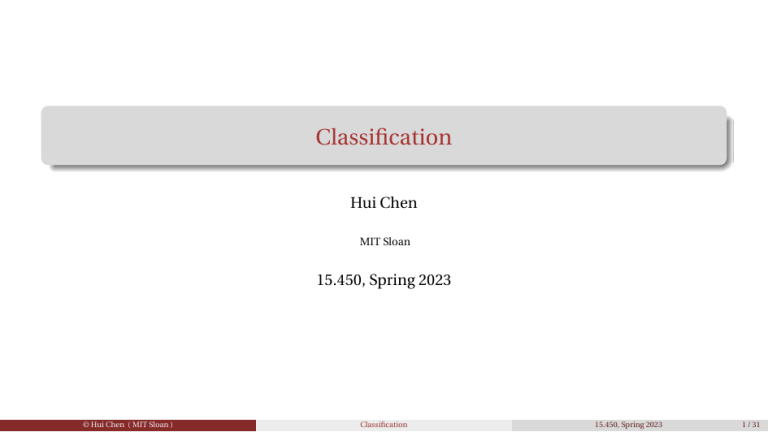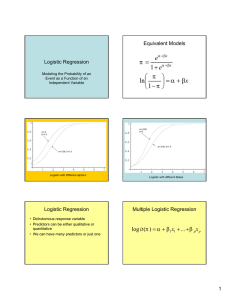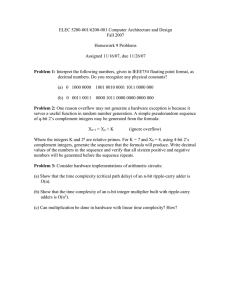
Classification
Hui Chen
MIT Sloan
15.450, Spring 2023
© Hui Chen ( MIT Sloan )
Classification
15.450, Spring 2023
1 / 31
Outline
1
Classification
2
Logistic Regression
3
K -Nearest Neighbors
2 / 31
Example: Credit Card Defaults
40000
20000
0
Income
60000
Source: ISL
0
500
1000
1500
2000
2500
Balance
3 / 31
Classification
Predicting binary or categorial data is referred to as classification.
Suppose y takes the value of 1 or 0 (e.g., default or solvent). We want to predict y using p
features, x.
Recall the multiple regression model:
yi = β′ xi + ε
,→ Not a good model, because the predicted value ŷi could be outside of [0, 1].
Instead, we can model the (conditional) probability of y taking on 0 or 1, given the
information contained in vector x.
p(y = 1|x) = F(x, θ)
p(y = 0|x) = 1 − F(x, θ)
Notice that we are still effectively modeling the expected value of y:
E[y|x] = p(y = 1|x) = F(x, θ)
4 / 31
Example: Credit Card Defaults
0
500
1000
1500
Balance
2000
| ||
2500
1.0
|
| || | ||||| || ||| ||||||||||| ||||| |||||||||||||||||| |||||||| ||||||||||| |||||||||||||||||||||||||||| ||||||||||||||||||||||||| | |||| | | | |
|
|
0.8
0.8
0.6
0.4
||||||||||||||||||||||||||||||||||||||||||||||||||||||
||||||||||||||
|||||||||||||||||||||||||||||
|||||||||||||
||||||||||||||||||||||||||||||||||
|||||||
|||||
|||||||||||||||||||
||||||||||||
||||||||||||||||
|||||||||||||
|||||||||||||||||||
|||||
||||
||||||||||||
|||||||||
||||
||||||||||||||
|||||||||||||||||||||||||||||||||||||||||||||||||||||
|||||||||||||||||||||||||
|||||||||||||||||||||||
|||||||||||||||||||||||||||||||||||||||||||||||||||||||||||||||||||||||||||| |||||| || || ||||| |
| |
0.6
|
0.4
|
0.2
| || | ||||| || ||| ||||||||||| ||||| |||||||||||||||||| |||||||| ||||||||||| |||||||||||||||||||||||||||| ||||||||||||||||||||||||| | |||| | | | |
Probability of Default
|
0.0
| |
0.2
0.0
Probability of Default
1.0
Source: ISL
||||||||||||||||||||||||||||||||||||||||||||||||||||||
||||||||||||||
|||||||||||||||||||||||||||||
|||||||||||||
||||||||||||||||||||||||||||||
||||
|||||||
|||||
|||||||||||||||||||
||||||||||||
||||||||||||||||
|||||||||||||
|||||||||||||||||||
|||||
||||
||||||||||||
|||||||||
||||
||||||||||||||
|||||||||||||||||||||||||||||||||||||||||||||||||||||
|||||||||||||||||||||||||
|||||||||||||||||||||||
|||||||||||||||||||||||||||||||||||||||||||||||||||||||||||||||||||||||||||| |||||| || || ||||| |
0
500
1000
1500
2000
| ||
2500
Balance
5 / 31
Classification
Many potential choices for F(). Would like F to be between 0 and 1 to give proper
probabilities.
Popular examples:
,→ Probit:
F(x, θ) = Φ(θ ′ x)
,→ Logit:
′
F(x, θ) = sigm(θ ′ x) =
eθ x
′
1 + eθ x
=
1
′
1 + e−θ x
6 / 31
Outline
1
Classification
2
Logistic Regression
3
K -Nearest Neighbors
7 / 31
Logistic Regression
Motivation
Log odds ratio:
LO ≡ log
p(y = 1|x)
p(y = 0|x)
LO is continuous and ranges between −∞ and +∞.
We can directly model LO as linear function of x:
LO = θ ′ x
This implies the logit model:
′
p(y = 1|x) =
eθ x
1 + eθ x
′
Q: Where is the error term?
8 / 31
Logistic Regression: Estimation with MLE
The observations y1 , y2 , · · · , yn are assumed to be IID binomial conditional on the features.
Likelihood function for yi :
Ã
yi
p(yi |xi , θ) = F(xi , θ) (1 − F(xi , θ))
1−yi
=
′
eθ xi
1 + eθ xi
′
!yi µ
¶1−yi
1
1 + eθ xi
′
Log-likelihood for Y :
L (θ) = log L(y1 , · · · , yn |x1 , · · · , xn , θ) =
n ¡
X
yi log F(xi , θ) + (1 − yi ) log(1 − F(xi , θ))
¢
i=1
¶ n ³
µ
³
´´
X
′
F(xi , θ)
=
yi log
+ log(1 − F(xi , θ)) =
yi θ ′ xi − log 1 + eθ xi
1 − F(xi , θ)
i=1
i=1
n
X
No closed-form solution in general, but “easy” to solve numerically, e.g., using glm or the
glmnet package in R.
9 / 31
Classification and Confusion Matrix
b we can make predictions:
After estimating the logistic regression coefficients θ,
b′
b(y = 1|x) =
p
eθ x
1 + eθ x
b′
We can also classify the data based on a cutoff rule with threshold p̄:
b(y = 1|x) > p̄; otherwise y = 0.
Predict y = 1 if p
How good are our predictions?
,→ Use the confusion matrix to compare the predicted and true classes of the observations.
10 / 31
Confusion Matrix
Predicted class
−
+
Total
True
−
True Neg. (TN)
False Pos. (FP)
N
class
+
False Neg. (FN)
True Pos. (TP)
P
Total
N∗
P∗
FP
N
Type II error rate (false negative) = FN
P
Type I error rate (false positive) =
11 / 31
Confusion matrix for predicting defaults
Predicted default
True default
status
No
Yes
Total
No
Yes
9,644
252
23
81
9,667
333
Total
9,896
104
10,000
Type I error rate (false positive):
Type II error rate (false negative):
12 / 31
0.4
0.2
0.0
Error Rate
0.6
Threshold p̄ and Type I/II errors
0.0
0.1
0.2
0.3
0.4
0.5
Threshold
13 / 31
Economic loss function
Suppose the dollar costs of making Type-I and Type II errors are LI and LII .
,→ What determines the magnitudes of LI and LII ?
Economic objective: Maximize the expected profit per application.
µ
¶
FP
P FN
N
1−
LI
+
(−LII )
N +P
N
P
}
|N + P {z
|
{z
}
profit of lending to a good borrower
N
=
LI
N
| +{zP }
maximum profit
loss of lending to a bad borrower
¶
N FP
P FN
LI +
LII
N +P N
N +P P
|
{z
}
µ
−
expected loss
Optimal decision rule: Choose p to minimize the expected economic losses.
14 / 31
Multi-class Logistic Regression
Suppose y takes value ℓ, where ℓ ∈ {1, · · · , C}.
Model the log odds ratio for class c relative to class C as:
log
p(y = c|x)
= θc′ x
p(y = C|x)
,→ Normalized against the C-th class; this choice does not matter.
,→ Notice that θc is a p × 1 vector that changes with c.
This implies
p(y = c|x, θ) =
exp(θc′ x)
,
PC−1
1 + ℓ=1 exp(θℓ′ x)
p(y = C|x, θ) =
1
PC−1
1 + ℓ=1 exp(θℓ′ x)
c = 1, · · · , C − 1
15 / 31
Example: Predicting Corporate Defaults
At firm level: the events of default, survival, exit, merger, etc. are categorical data: Yit = {0, 1}
Pre-default, we observe firm and market information: Xit
Forecasting model: Connect firm and market characteristics to the likelihoods of default.
,→ Logit and Probit
,→ Rating-migration model (e.g. S&P)
,→ Hazard model
16 / 31
Logit Model
Example: Predicting Corporate Defaults
Marginal probability of default over the next period:
Pt−1 (Yit = 1) =
1
1 + exp(−β′ Xi,t−1 )
,→ Xi,t−1 : vector of explanatory variables (covariates)
Long horizon:
Pt−1 (Yi,t−1+j = 1|Yi,t−2+j = 0) =
1
1 + exp(−β′j Xi,t−1 )
,→ How to calculate Pt−1 (Yi,t = 0, · · · , Yi,t+j = 0)?
,→ Cumulative default probability no longer has logit form.
,→ Not fully utilizing the information in the dynamics of Xi,t .
17 / 31
2904 Hilscher, Szilagyi
The Journal of Finance
Example: Campbell,
(JF 2008)
Table I
Number of Bankruptcies and Failures per Year
This table lists the total number of active firms, bankruptcies, and failures for every year of our
sample period. The number of active firms is computed by averaging over the numbers of active
firms across all months of the year.
Year
Active Firms
Bankruptcies
(%)
Failures
(%)
1963
1964
1965
1966
1967
1968
1969
1970
1971
1972
1973
1974
1975
1976
1977
1978
1979
1980
1981
1982
1983
1984
1985
1986
1987
1988
1989
1990
1991
1,281
1,357
1,436
1,513
1,598
1,723
1,885
2,067
2,199
2,650
3,964
4,002
4,038
4,101
4,157
4,183
4,222
4,342
4,743
4,995
5,380
5,801
5,912
6,208
6,615
6,686
6,603
6,515
6,571
0
2
2
1
0
0
0
5
4
8
6
18
5
14
12
14
14
26
23
29
50
73
76
95
54
84
74
80
70
0.00
0.15
0.14
0.07
0.00
0.00
0.00
0.24
0.18
0.30
0.15
0.45
0.12
0.34
0.29
0.33
0.33
0.60
0.48
0.58
0.93
1.26
1.29
1.53
0.82
1.26
1.12
1.23
1.07
0
2
2
1
0
0
0
5
4
8
6
18
5
14
12
15
14
26
23
29
50
74
77
95
54
85
78
82
73
0.00
0.15
0.14
0.07
0.00
0.00
0.00
0.24
0.18
0.30
0.15
0.45
0.12
0.34
0.29
0.36
0.33
0.60
0.48
0.58
0.93
1.28
1.30
1.53
0.82
1.27
1.18
1.26
1.11
18 / 31
Example: Campbell, 2910
Hilscher, Szilagyi
(JF 2008)
The Journal of Finance
Table III
Logit Regressions of Bankruptcy/Failure Indicator
on Predictor Variables
This table reports results from logit regressions of the bankruptcy and failure indicators on predictor variables. The data are constructed such that all of the predictor variables are observable at
the beginning of the month over which bankruptcy or failure is measured. The absolute value of
z-statistics is reported in parentheses. ∗ denotes significant at 5%, ∗∗ denotes significant at 1%.
Model 1
Model 2
Dependent variable: Bankruptcy
Failure
Failure
Bankruptcy
Failure
Failure
Sample period:
1963–1998 1963–1998 1963–2003 1963–1998 1963–1998 1963–2003
NITA
−14.05
(16.03)∗∗
−13.79
(17.06)∗∗
−12.78
(21.26)∗∗
5.38
(25.91)∗∗
4.62
(26.28)∗∗
3.74
(32.32)∗∗
−3.30
(12.12)∗∗
−2.90
(11.81)∗∗
−2.32
(13.57)∗∗
2.15
(16.40)∗∗
−0.188
(5.56)∗∗
2.28
(18.34)∗∗
−0.253
(7.60)∗∗
2.76
(26.63)∗∗
−0.374
(13.26)∗∗
−15.21
(39.45)∗∗
1,282,853
797
0.260
−15.41
(40.87)∗∗
1,302,564
911
0.258
−16.58
(50.92)∗∗
1,695,036
1,614
0.270
NIMTAAVG
TLTA
TLMTA
EXRET
EXRETAVG
SIGMA
RSIZE
CASHMTA
MB
PRICE
Constant
Observations
Failures
Pseudo-R2
−32.52
(17.65)∗∗
−32.46
(19.01)∗∗
−29.67
(23.37)∗∗
4.32
(22.82)∗∗
3.87
(23.39)∗∗
3.36
(27.80)∗∗
−9.51
(12.05)∗∗
0.920
(6.66)∗∗
0.246
(6.18)∗∗
−4.89
(7.96)∗∗
0.099
(6.72)∗∗
−0.882
(10.39)∗∗
−7.65
(13.66)∗∗
1,282,853
797
0.299
−8.82
(12.08)∗∗
1.15
(8.79)∗∗
0.169
(4.32)∗∗
−3.22
(6.59)∗∗
0.095
(6.76)∗∗
−0.807
(10.09)∗∗
−8.45
(15.63)∗∗
1,302,564
911
0.296
−7.35
(14.03)∗∗
1.48
(13.54)∗∗
0.082
(2.62)∗∗
−2.40
(8.64)∗∗
0.054
(4.87)∗∗
−0.937
(14.77)∗∗
−9.08
(20.84)∗∗
1,695,036
1,614
0.312
19 / 31
Example: Campbell, Hilscher,InSzilagyi
(JFRisk
2008)
Search of Distress
2913
Table IV
Logit Regressions of Failure Indicator on Lagged Variables
This table takes our best-model variables (model 2 in Table III) and reports their predictive power
for lags of 6, 12, 24, and 36 months. The dependent variable is failure and the sample period is
1963 to 2003. The absolute value of z-statistics is reported in parentheses. ∗ denotes significant at
5%, ∗∗ denotes significant at 1%.
Lag (Months)
0
6
12
24
36
NIMTAAVG
−29.67
(23.37)∗∗
3.36
(27.80)∗∗
−7.35
(14.03)∗∗
1.48
(13.54)∗∗
0.082
(2.62)∗∗
−2.40
(8.64)∗∗
0.054
(4.87)∗∗
−0.937
(14.77)∗∗
−9.08
(20.84)∗∗
1,695,036
1,614
0.312
−23.92
(21.82)∗∗
2.06
(22.63)∗∗
−7.79
(15.97)∗∗
1.27
(14.57)∗∗
0.047
(2.02)∗
−2.40
(9.77)∗∗
0.047
(4.22)∗∗
−0.468
(10.36)∗∗
−8.07
(25.00)∗∗
1,642,006
2,008
0.188
−20.26
(18.09)∗∗
1.42
(16.23)∗∗
−7.13
(14.15)∗∗
1.41
(16.49)∗∗
−0.045
(2.09)∗
−2.13
(8.53)∗∗
0.075
(6.33)∗∗
−0.058
(1.40)
−9.16
(30.89)∗∗
1,565,634
1,968
0.114
−13.23
(10.50)∗∗
0.917
(9.85)∗∗
−5.61
(10.14)∗∗
1.52
(16.92)∗∗
−0.132
(6.19)∗∗
−1.37
(5.09)∗∗
0.108
(7.92)∗∗
0.212
(4.96)∗∗
−10.23
(34.48)∗∗
1,384,951
1,730
0.061
−14.06
(9.77)∗∗
0.643
(6.25)∗∗
−2.56
(4.14)∗∗
1.33
(13.54)∗∗
−0.180
(8.03)∗∗
−1.41
(4.61)∗∗
0.125
(8.17)∗∗
0.279
(6.00)∗∗
−10.53
(33.53)∗∗
1,208,610
1,467
0.044
TLMTA
EXRETAVG
SIGMA
RSIZE
CASHMTA
MB
PRICE
Constant
Observations
Failures
Pseudo-R2
20 / 31
Example: Rating-Migration Model
How to forecast the probability of default of a particular bond/firm?
Credit rating agencies provide credit rating to bonds, which provide (their) assessment of
their probability of default
Example: Standard and Poor’s rating transition matrix
Rating at the end of the year
Initial
Rating
AAA
AA
A
BBB
BB
B
CCC
D
AAA
0.8910
0.0086
0.0009
0.0006
0.0004
0.0000
0.0000
0.0000
AA
0.0963
0.9010
0.0291
0.0043
0.0022
0.0019
0.0000
0.0000
A
0.0078
0.0747
0.8894
0.0656
0.0079
0.0031
0.0116
0.0000
BBB
0.0019
0.0099
0.0649
0.8427
0.0719
0.0066
0.0116
0.0000
BB
0.0030
0.0029
0.0101
0.0644
0.7764
0.0517
0.0203
0.0000
B
0.0000
0.0029
0.0045
0.0160
0.1043
0.8246
0.0754
0.0000
CCC
0.0000
0.0000
0.0000
0.0018
0.0127
0.0435
0.6493
0.0000
D
0.0000
0.0000
0.0009
0.0045
0.0241
0.0685
0.2319
1.0000
21 / 31
Outline
1
Classification
2
Logistic Regression
3
K -Nearest Neighbors
22 / 31
where N (x) is some neighborhood of x.
3
A non-parametric approach
2
●
●
●
●
●●
0
y
1
●
●
●
−1
●
●
●●
●
●●
● ● ●
●
●
●
●●
●
● ●
● ●
●
● ●
●
●
●
●
● ●
●
● ●
● ●
●
−2
●
●
●
●
●
●●
●
● ●
●
● ●●
●
●
●
●
●
● ●
● ● ●●
●
●
1
2
3
4
5
6
x
Instead of fitting a (linear) function to the data, try predicting the value for y based on the
observations nearby.
23 / 31
K -Nearest Neighbors
One way to predict whether a borrower with attributes x0 will default or not is to look at
how often the other borrowers who are “similar” to him (neighbors) default in the data.
KNN applies the following procedure:
1
Identify K points in the training data that are closest to x0 , denoted by N0 .
2
The conditional probability of y belonging to class c is:
p(y = c|x = x0 ) =
1 X
I(yi = c)
K i∈N
0
3
4
Pick a set of cutoff probabilities, pc , c = 1, · · · , C − 1, such that we classify y as in class c if
p(y = c|x = x0 ) > pc .
Obtain the KNN decision boundary in the feature space.
24 / 31
K -Nearest Neighbors
Source: ISL
o
o
o
o
o
o
o
o
o
o
o
o
o
o
o
o
o
o
o
o
o
o
o
o
25 / 31
How to measure the distance?
How to measure the distance between data points?
Real-valued features: First standardize each of the features to have zero mean and unit
variance. Then use the Euclidean (squared) distance in feature space:
di = ∥xi − x0 ∥
Qualitative features:
½
di =
0
1
xi = x0
xi ̸= x0
26 / 31
Size matters
4
10
x2
x2
2
0
0
−2
−10
−4
−4
−2
0
x1
2
4
−10
0
5x1
10
27 / 31
K -Nearest Neighbors
Source: ISL
KNN: K=10
oo o
o
o
o
oo oo o
o
o
o
o
o oo
o
oo oo
oo o
oo
o oo o
oo o o
o
o
oo o
o oo
oo
o
o o o oo
o
o
o
o
o
o
o o
o
o
o o
o oo o
o o
o
o o o
o
o oo
o o
o
o o oooo o
ooo o o o o
o
oo
o o oo o o oo
o
o
o
o
o
o
o
oo o oo o
oo o
o o oo o
o o
o
o
o
o
o
o o o oo o oo o
o
o
o
o
o
o ooooo oo
oo
o
o
o
o oo o o
o
o o
oo oo o
o
o
o
o
o
o
o ooo
oo
o
o
oo o
o
o
o o
oo
X2
o
X1
28 / 31
The choice for K
Source: ISL
KNN: K=1
oo
o
o
o
oo
o
o
oo
o
o
o
o
o
oo oo o o
oo
o
o
o
o
o
oo
o oo
oo o o
o
o
oo o
o
oo
oo
o
o
o
o o o
o
o o
o
o
o
o o
o
o
o o
o oo o
o o
o
o o
o
o oo
o
o
o
o o
o
o o ooo o
ooo o
o
ooo
oo
o
o
o
o
o o ooooo o
oo
o
o
o o o
oo o
o o oo o
oo o
o
o o o oo
o oo o
o o o
o
o
oo
o o o
o
oo
oooo ooo
o
o
o oo o o
o
o o
oo oo o
o
oo o
o
o
oooo
oo
o
o
oo o
o
o
oo
o
KNN: K=100
o
oo
o
o
o
o
o
o
o
o
o
oo
o
o
o
o
oo oo o o
oo
o
o
o
o
oo
o oo
oo o o
o
o
oo o
o
oo
oo
o
o
o
o o o
o
o o
o
o
o
o o
o
o
o o
o oo o
o o
o
o o
o
o oo
o
o
o
o o
o
o o ooo o
ooo o
o
ooo
oo
o
o
o
o
o o ooooo o
oo
o
o
o o o
oo o
o o oo o
oo o
o
o o o oo
o oo o
o o o
o
o
oo
o o o
o
oo
oooo ooo
o
o
o oo o o
o
o o
oo oo o
o
oo o
o
o
oooo
oo
o
o
oo o
o
o
o
o
How to choose K ? Cross validation (later).
29 / 31
Default Forecasting in FinTech
Big data and machine learning methods
,→ No reason for the relation between log default prob and covariates to be linear.
,→ Superior ability to predict defaults has become the core competitive advantage for some
FinTech companies (e.g., Alibaba, LendingClub ...)
Example: Alibaba’s microlending platform
,→
,→
,→
,→
,→
,→
Borrowers: over 400k/per year
Total credit: exceeding $40 bil
Loan size: as small as 100 RMB ($15)
100% unsecured
NPL: < 1%
Beyond standard info: user ratings, “punishment records”, repeat buyers ...
The frontier:
,→ Correlate defaults: Jointly model many borrowers.
,→ “Small data”: Large XS helps little with estimating aggregate default risk.
,→ Robust credit screening
30 / 31
Summary
Logistic regression
Confusion matrix, Type I/II errors
KNN
ISL Chapter 2.2.3, 4.1-4.3
31 / 31


